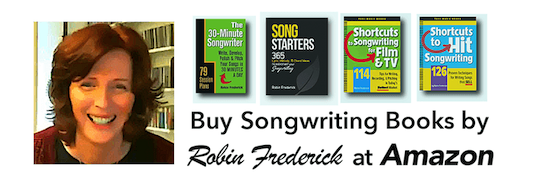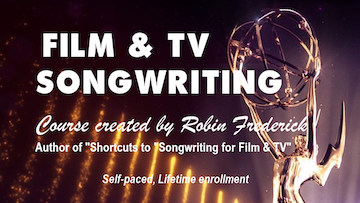Singer-songwriter duo The Civil Wars won the 2012 Grammy for Best Country Duo/Group Performance and another for Best Folk Album. Joy WIlliams and Paul White were working as solo singer-songwriters before teaming up to create a unique blend that lets each of them shine. This is a great example of collaboration! They obviously share a love for folk music and were able to find a way to pool their talents and make a whole that’s different from their work as solo artists.
The emotional, atmospheric quality of the tracks makes them perfect for film and television. And indeed, “Poison & Wine” has been featured Grey’s Anatomy, Vampire Diaries, The Client List, Pretty Little Liars, 90210, and more. So let’s take a look.
SONG GUIDE
“Poison & Wine” by The Civil Wars
Songwriters: Chris Lindsey / John White / Joy Williams
TECHNIQUES TO HEAR AND TRY:
• Use a traditional folk song structure.
• Maintain a tight lyric focus in a duet.
• Write a three-chord song.
• Create a melody that builds as the song moves along.
Watch on YouTube
Read the lyrics.
Shortcut numbers refer to my books “Shortcuts to Hit Songwriting” (“Hit”) and “Shortcuts to Songwriting for Film & TV” (“Film/TV”).

GENRE/STYLE: (Pop)
(What is a genre? Watch this video.)
Just as the 1960’s Folk song genre evolved from and altered the sound of an earlier Folk music tradition, so today’s Indie Folk style has morphed the ’60s sound into something new, more moody, personal, and passionate. This song is a great example of the current Folk style. The Civil Wars’ sound is a mix of ’60s folk a la Ian & Sylvia with a contemporary Indie edge that pushes the emotional aspect.
STRUCTURE
The song has a traditional folk song structure – as simple and straightforward as a genuine folk song from long ago. It consists of a four-line verse with a repeated refrain line at the end – “Oh I don’t love you but I always will”. (See “Hit” Shortcut #23.) To give a refrain line like this plenty of impact, be sure that the line is emotionally compelling and intriguing. This gives the singer something to work with and draws listeners into the heart of the song.
The structure is…
VERSE / REFRAIN / VERSE / REFRAIN (repeated to end)
That’s all! True to the traditional folk form, there’s no bridge and no big, scene-stealing chorus. There’s just a slow emotional build from beginning to end.
LYRICS
This lyric harks back to the bleak, haunted ballads of the Appalachian mountains and the Celtic songs of Britain, Scotland, and Ireland. It’s no coincidence that The Civil Wars were asked to write and sing a song with The Chieftains (“Lilly Love”).
The lyric circles around the contradictory refrain line: “I don’t love you and I always will.” Each of the verse lines is answered by – or contains – an opposite or negation. “Your mouth is poison. Your mouth is wine” “I don’t have a choice but I’d still choose you.” The lyrics recall both the inner conflict of an addictive/destructive love relationship and the riddle songs of the Celtic tradition, such as “I Gave My Love a Cherry.” The lyrics feel both contemporary and ancient.
The risk in writing this type of lyric is that the riddle or contradiction may make the listener start thinking about what the song is saying, rather than emotionally feeling it. If listeners start thinking about a line, they’re going to miss the lines that follow. Therefore, a lyric that tells a story or conveys a lot of information won’t work well in a song like this. Stick with phrases that convey a peak emotional moment and repeat your central idea in different, intriguing ways. Then, if listeners stop to think, they can always jump back in and they haven’t missed any vital information. (Shortcut #51 in “Film/TV” can tell you more about conveying a peak emotional moment.)


CHORDS
The chord progression is simple yet haunting. It’s basically the same three chords throughout: | C | G | F | F |. To play along with the recording, capo your guitar up to the second fret. For keyboards with a transpose function, go up two half-steps. They’re only playing some of the notes in the chord – leaving out the middle note, the 3rd of the scale. This opens the chord up and gives it a droning, modal feel.
MELODY
In the first verse, the female vocal echoes the male. The verse melody goes back and forth between the two singers, changing octaves as it does. To pick up the emotional energy and create contrast in the repeated refrain lines, they simply increase the pace of the phrasing – there are shorter pauses between the lines (“Hit” Shortcut #92). Adding harmony helps, too.
The melody of the second verse helps to keep the energy building. Here, the melody is embellished, phrases are lengthened with extra notes at the end. The second verse starts with the female vocal, instead of the male. She adds extra high notes and lifts the whole line a little higher.
PRODUCTION
The production of this song is simple but fills the sonic space and vocals are heavily featured. It starts with piano and muted guitar. A low synth enters at the chorus. The second verse continues the build with bass and more strength on the piano, supporting the vocals. The track continues to build by adding a second, higher guitar, electric guitar, and a few additional synth lines in the background. The essential sound is very organic. You can do this type of production in a home studio. (For more on listening to and analyzing a production like this one, see “Film/TV” Shortcuts #73 and #74.)
In this style, the vocal must carry the track. Both singers convey a strong sense of character and emotional authenticity. Phrasing is a big part of creating this effect – it’s very close to the way the line would be spoken with a lot of emotion. When singing together the voices blend well yet still retain individuality.
Try It Now
Try writing a song in the folk song form of this song. Look for a strong, emotionally-driven title to use as your refrain line, then write the lines that lead up to it. Record a simple guitar/vocal or keyboard/vocal in this style. Try speaking the lines with a lot of emotion just before recording your vocal.
